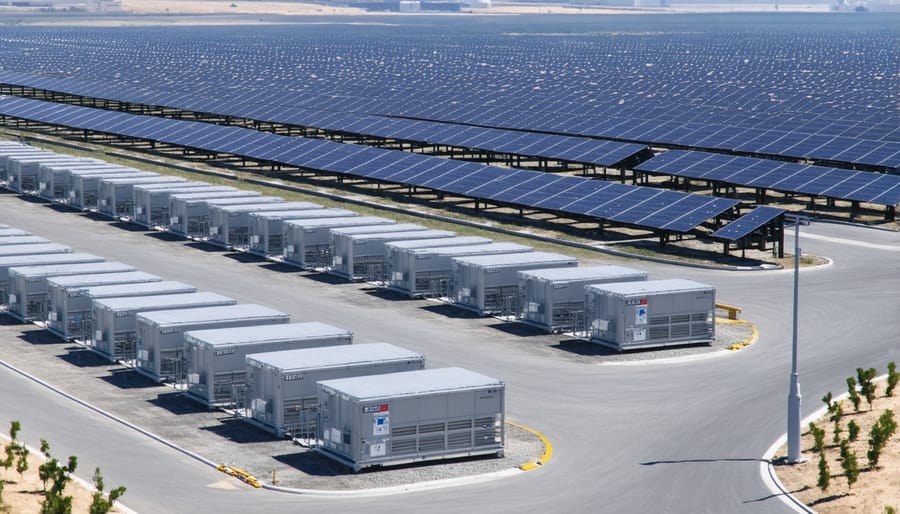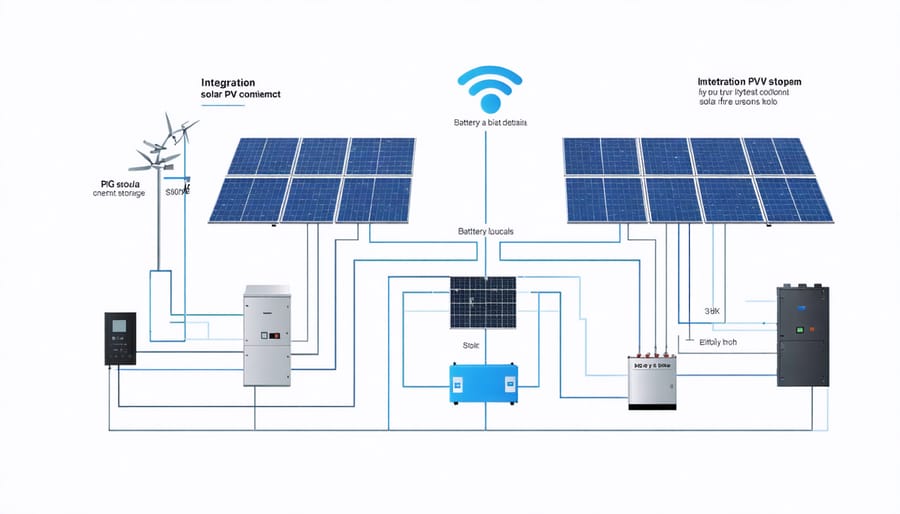Utility-scale energy storage stands at the forefront of our global energy transition, enabling power grids to harness renewable energy sources with unprecedented efficiency. As renewable energy generation continues to expand, large-scale storage solutions have become critical infrastructure components, capable of storing hundreds of megawatt-hours and providing grid stability during peak demand periods.
The evolution of utility-scale storage technologies—from advanced lithium-ion batteries to innovative flow battery systems—has transformed the economics of renewable energy integration. These systems now offer grid operators the flexibility to balance supply and demand, reduce transmission congestion, and maintain power quality across vast networks. In 2023 alone, global utility-scale storage deployments exceeded 100 gigawatt-hours, marking a pivotal shift in how utilities approach grid modernization.
For utilities, municipalities, and large industrial consumers, energy storage represents more than just backup power—it’s a strategic asset that enhances grid resilience, enables renewable energy optimization, and provides substantial economic returns through peak shaving and energy arbitrage. As costs continue to decline and technologies mature, utility-scale storage is becoming an indispensable element in the modern energy landscape, promising a more reliable, sustainable, and cost-effective power infrastructure.
The Business Case for Utility-Scale Storage
Peak Demand Management
Utility-scale energy storage systems play a crucial role in peak demand management, helping organizations significantly reduce their electricity costs while maintaining reliable operations. These systems strategically store energy during low-demand periods when rates are lower and deploy it during peak hours when electricity prices surge.
By implementing advanced storage solutions, facilities can effectively “peak shave” their energy consumption profile, reducing or eliminating costly demand charges that often account for up to 50% of commercial electricity bills. Modern storage systems utilize sophisticated algorithms and predictive analytics to optimize charging and discharging cycles, automatically responding to facility load patterns and utility rate structures.
For example, a manufacturing facility in California implemented a 2MW storage system that reduced their peak demand charges by 30%, resulting in annual savings of $300,000. Similar success has been observed in commercial buildings, where storage systems work in conjunction with building management systems to predict and manage peak load events.
The financial benefits extend beyond direct cost savings, as reduced grid strain during peak periods can qualify organizations for utility incentives and demand response program payments.

Grid Stability Benefits
Utility-scale energy storage systems deliver substantial financial benefits through enhanced grid stability and power quality management. When integrated with smart grid management systems, these installations can provide immediate frequency regulation, voltage support, and peak load management services.
Grid operators can generate additional revenue streams by participating in ancillary service markets, offering frequency regulation and spinning reserve capacity. Studies show that facilities providing these grid services can achieve ROI improvements of 15-25% compared to pure energy arbitrage applications.
Power quality enhancement through energy storage systems reduces equipment damage, minimizes downtime, and extends the lifespan of grid infrastructure. This translates to significant cost savings for utilities and industrial consumers alike. For example, a 50MW battery storage facility in California reported annual savings of $3.5 million in reduced maintenance costs and improved power quality metrics.
The stabilizing effect of these systems also enables greater integration of renewable energy sources while maintaining grid reliability, creating a more resilient and efficient power network.

Current Storage Technologies
Advanced Battery Systems
Lithium-ion batteries remain the cornerstone of utility-scale energy storage, offering proven reliability and increasingly competitive costs. These systems have evolved significantly, now achieving energy densities of 250-300 Wh/kg, with cycle lives extending beyond 3,000 cycles under optimal conditions. Recent advancements in electrode materials and battery management systems have substantially improved their performance and longevity.
Emerging technologies are reshaping the landscape of energy storage. Solid-state battery technology promises enhanced safety and energy density, potentially offering up to 50% more storage capacity than traditional lithium-ion systems. Flow batteries, particularly vanadium redox flow batteries, are gaining traction for their scalability and ability to decouple power from energy capacity.
These advanced systems incorporate sophisticated thermal management and state-of-charge monitoring, ensuring optimal performance across varying environmental conditions. Modern battery installations feature modular designs, facilitating easier maintenance and future capacity expansion. Integration with artificial intelligence and machine learning algorithms enables predictive maintenance and dynamic load management, maximizing system efficiency and extending operational lifespan.
Industry leaders are increasingly adopting hybrid solutions that combine different battery technologies to optimize performance and cost-effectiveness. This approach allows facilities to leverage the specific advantages of each technology while mitigating their respective limitations, resulting in more robust and flexible energy storage solutions.
Alternative Storage Methods
While lithium-ion batteries dominate the utility-scale storage market, several alternative storage methods offer unique advantages for specific applications. Pumped hydroelectric storage remains the most widely deployed large-scale storage solution globally, accounting for over 90% of installed capacity. This proven technology utilizes two reservoirs at different elevations, pumping water uphill during excess energy periods and releasing it through turbines when power is needed.
Compressed Air Energy Storage (CAES) presents another viable option, particularly in regions with suitable geological formations. This method compresses air into underground caverns or vessels during off-peak periods, releasing it later to generate electricity through turbines. Modern CAES systems achieve efficiency rates of up to 70% and can provide sustained power output for extended periods.
Advanced hydrogen fuel cell storage systems are gaining traction as a flexible storage solution, especially for longer-duration applications. These systems convert excess renewable energy into hydrogen through electrolysis, storing it for later use in fuel cells to generate clean electricity on demand.
Flywheel energy storage systems excel in high-power, short-duration applications, offering rapid response times and high cycle efficiency. Though limited in energy capacity, flywheels prove valuable for grid stabilization and power quality management.
Thermal energy storage, including molten salt systems commonly used in concentrated solar power plants, provides another cost-effective solution for specific applications. These systems can maintain high temperatures for extended periods, enabling consistent power generation even after sunset.
Each storage technology offers distinct advantages and limitations, making them suitable for different scenarios based on factors such as geographic location, power requirements, and duration needs. Successful utility-scale projects often combine multiple storage technologies to create optimal solutions for specific grid requirements and local conditions.
Integration with Solar PV Systems

System Design Considerations
When designing utility-scale energy storage systems, several critical factors must be considered to ensure optimal performance and return on investment. The system’s capacity needs to be carefully calculated based on peak demand patterns, local grid requirements, and anticipated future growth. This includes analyzing historical load profiles and projected energy consumption trends.
Location selection plays a vital role in system efficiency. Factors such as proximity to existing transmission infrastructure, available land area, and environmental conditions directly impact both installation costs and operational effectiveness. Temperature control systems and protective enclosures must be designed to maintain optimal battery performance across varying weather conditions.
Integration with existing grid infrastructure requires sophisticated power conversion systems and control mechanisms. These systems must be capable of responding rapidly to fluctuating demand while maintaining grid stability. Advanced monitoring and management systems are essential for real-time performance tracking and predictive maintenance.
Safety considerations are paramount, particularly for battery-based systems. This includes implementing robust fire suppression systems, thermal runaway protection, and emergency shutdown protocols. Regular maintenance schedules and replacement strategies should be planned from the outset to maximize system lifespan and maintain performance levels.
Scalability should be built into the initial design to accommodate future expansion. This includes planning for additional storage capacity, upgraded power conversion systems, and enhanced control capabilities as needs evolve. The design should also consider potential technology advances and compatibility with emerging storage solutions.
Performance Optimization
Maximizing the performance of utility-scale energy storage systems requires a comprehensive approach to energy efficiency optimization and strategic management. Key strategies include implementing advanced battery management systems (BMS) that monitor and control individual cell performance, temperature regulation, and charge/discharge cycles.
Regular predictive maintenance schedules help identify potential issues before they impact system performance. This includes monitoring battery degradation rates, conducting thermal imaging inspections, and analyzing performance data to optimize operational parameters.
Smart grid integration plays a crucial role in performance optimization. By leveraging artificial intelligence and machine learning algorithms, storage systems can better predict demand patterns and adjust their operation accordingly. This predictive capability enables more efficient cycling and reduces unnecessary wear on storage components.
Environmental controls are equally important. Temperature management systems maintain optimal operating conditions, while humidity control prevents corrosion and extends equipment life. Modern facilities often incorporate automated environmental management systems that adjust in real-time to changing conditions.
Financial returns can be maximized through strategic dispatch timing. This involves charging during low-cost periods and discharging during peak demand when electricity prices are highest. Advanced energy management software helps facility operators make data-driven decisions about when to store and release energy, ensuring optimal economic performance while maintaining system reliability.
Implementation Success Stories
Several notable utility-scale energy storage projects have demonstrated remarkable success in recent years, providing valuable insights for future implementations. The Hornsdale Power Reserve in South Australia, featuring a 150MW/194MWh Tesla battery system, has exceeded expectations since its 2017 launch. The facility has saved consumers over $150 million in grid stabilization costs while providing crucial frequency control services to the region’s electrical grid.
In California, the Moss Landing Energy Storage Facility stands as one of the world’s largest battery storage installations. The 400MW/1,600MWh project, operated by Vistra Energy, has successfully demonstrated how utility-scale storage can effectively manage peak demand and integrate renewable energy sources. The facility has proven particularly valuable during extreme weather events, helping maintain grid stability and prevent blackouts.
The AES Alamitos Battery Energy Storage System in Long Beach, California, represents another success story. This 100MW/400MWh installation has effectively replaced traditional gas peaker plants, providing rapid response times and significantly reducing carbon emissions. The project has achieved a 98% availability rate while delivering essential grid services and energy arbitrage opportunities.
In the United Kingdom, the Minety Battery Storage Project showcases successful implementation in a different market context. The 100MW facility, operational since 2021, has demonstrated how large-scale storage can support the national grid’s transition to renewable energy. The project has consistently delivered strong financial returns while providing critical balancing services to the UK power system.
Japan’s Hokkaido Electric Power Company has implemented a 15MW/60MWh storage system that effectively manages solar power integration challenges. The project has successfully addressed grid stability issues in a region with high renewable energy penetration, maintaining power quality while enabling further solar capacity expansion.
These implementations share common success factors: thorough planning, strategic site selection, robust maintenance protocols, and close collaboration with grid operators. They’ve demonstrated the technical feasibility and economic viability of utility-scale storage while providing valuable lessons for future projects in different market contexts and regulatory environments.
Utility-scale energy storage stands at the forefront of our transition to a more resilient and sustainable energy future. As demonstrated throughout this discussion, large-scale storage solutions have become increasingly viable, with costs continuing to decline and technologies becoming more sophisticated. The combination of lithium-ion batteries, pumped hydro storage, and emerging technologies provides utilities and grid operators with a robust toolkit to address intermittency challenges and enhance grid stability.
Looking ahead, the market for utility-scale storage is projected to grow exponentially, with estimates suggesting a tenfold increase in global deployment by 2030. This growth will be driven by improved technology performance, declining costs, and supportive policy frameworks across major markets. The integration of artificial intelligence and advanced control systems will further optimize storage operations, maximizing both efficiency and return on investment.
For stakeholders considering implementation, the key takeaways are clear: early adoption can provide competitive advantages, careful planning and system integration are essential for success, and the benefits extend beyond mere energy storage to include grid services, peak shaving, and enhanced reliability. As renewable energy penetration increases and grid modernization continues, utility-scale storage will become not just an option but a necessity for maintaining stable, efficient, and sustainable power systems.
The future of utility-scale storage looks promising, with continued innovation and scale economies expected to drive further improvements in both technology and economics. Organizations that embrace these solutions today will be well-positioned to lead in tomorrow’s energy landscape.

